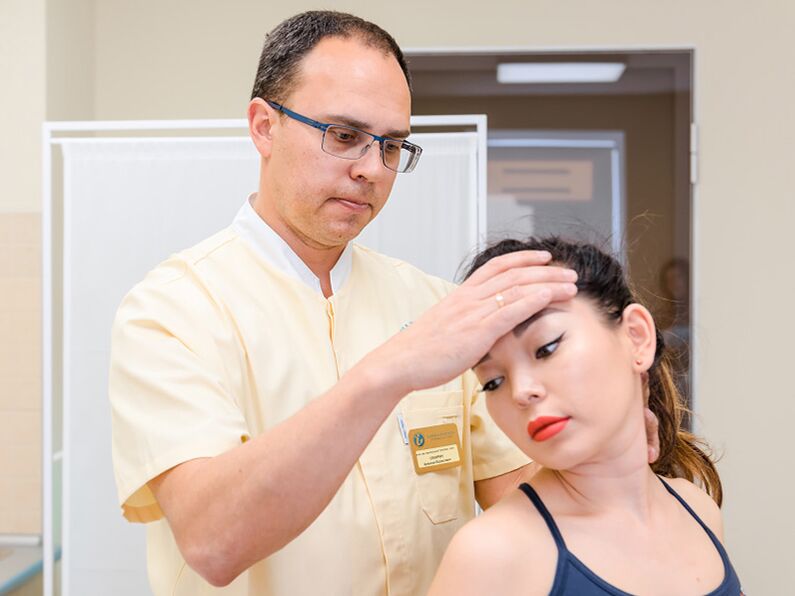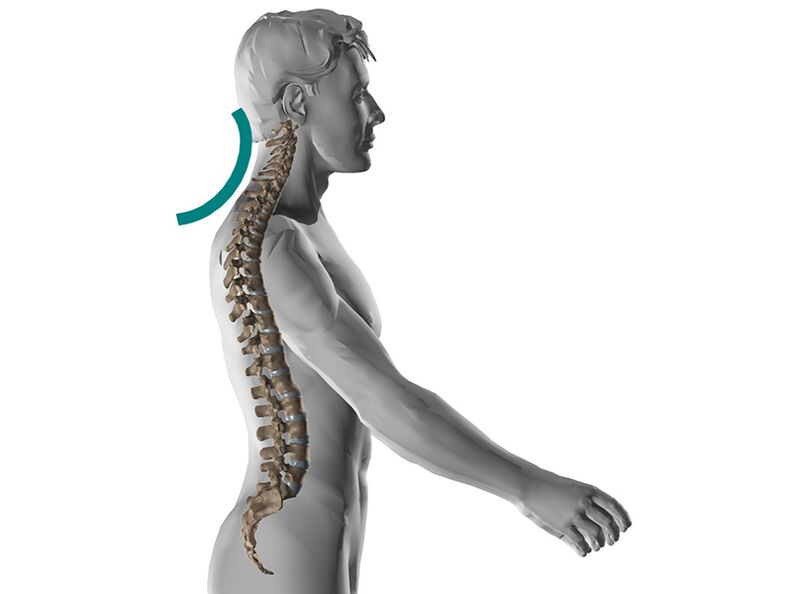Cervical osteochondrosis is a common degenerative-dystrophic disease that develops in the cervical spine. In women, a weak muscle corset, as well as thin bone tissue, leads to faster development of the pathology. The symptoms of cervical osteochondrosis in women are intense. When they occur, treatment should begin immediately.
Causes of developing cervical osteochondrosis in women
Cervical osteochondrosis in women can develop in the presence of a variety of risk factors. The development of the pathology is diagnosed, regardless of the age of the patient. The causes of osteochondrosis in women are:
- Insufficient physical activity.
- sedentary work;
- Sedentary life.

The appearance of pathology of the cervical region of the cervical thorax is diagnosed with frequent hormonal failures. If during the period of birth of a child, the load on the spine increases, then this leads to the appearance of this disease. Improper diet throughout life becomes the cause of metabolic disorders. All this leads to the development of the disease.
Older women are at risk for developing the disease. A fairly common cause of osteochondrosis is hypothermia. The disease can develop with injuries. With injuries, the appearance of disc diseases in women is diagnosed. The pathology often develops in the context of infectious processes.
Osteochondrosis in the fair sex develops under the influence of various factors. That's why you have to take responsibility for your health.
Signs of osteochondrosis in women
Signs of osteochondrosis in women appear some time after the onset of the degenerative process. Quite often there is a protrusion of the vertebrae from their boundaries, which leads to worsening of the condition, as they thin at the same time. As part of the inflammatory processes in the intervertebral discs, pain is diagnosed, which can be permanent or temporary.
During the disease, the brain tissue is destroyed, which causes headaches. When compressing the vertebral artery with cervical osteochondrosis, dizziness may be diagnosed. Very often, women of the weaker sex experience changes in blood pressure. During the development of cervical osteochondrosis, women may experience fainting.
In some cases, with pathology, patients have hearing loss. During osteochondrosis in women, the symptoms manifest themselves in the form of a change in gait. The pathological process leads to frequent mood swings. Most patients are diagnosed with severe fatigue even when performing daily tasks. Symptoms may be manifested as reduced vision. When the disease significantly worsens the condition of the teeth, which leads to the development of a variety of dental diseases. Some people are diagnosed with spasms of the back and neck muscles. With this pathology, the volume of the voice can be reduced.
The disease negatively affects the state of the brain, which leads to a deterioration of memory and thought processes. Some patients experience snoring during sleep. This is due to the fact that during sleep there is tension in the neck muscles. The most common of the symptoms is radical syndrome. Its appearance is diagnosed when the nerves in the cervical vertebrae are compressed.

As the disease affects the nervous system, it leads to numbness of the fingers, which makes it impossible to perform the most important tasks related to fine motor skills. Symptoms appear as weakness in the hands. If osteochondrosis of the chest or lumbar region is diagnosed, then this leads to back pain. If the area of the cervix is affected, the head or neck suffers. The pain may radiate to the back as well as the extremities. Sleep disorders are often diagnosed.
After the age of 50, the signs of osteochondrosis in women are more pronounced.
Treatment of cervical osteochondrosis in women
When symptoms occur, it is necessary to treat cervical osteochondrosis in women immediately. First of all, joint pain is eliminated. Before treating osteochondrosis in women, it is necessary to perform appropriate tests. This will allow the appointment of rational therapy.
The main treatment starts only after the patient is fully examined. The most common methods of treating joints include drug therapy. In this case, the use of topical preparations is recommended.
When an illness occurs, the main treatment begins only after consulting a doctor. If topical preparations are not effective enough, then the use of tablet formulations is recommended. In most cases, after such a treatment, the pain disappears completely. If severe muscle pain is observed, then the use of anesthetic injections is recommended.
With pain relief, the main treatment in most cases helps. But, to improve its effectiveness, you can use folk methods. The use of funds is recommended to eliminate pain in the shoulder joint and neck. The characteristics of the treatment of osteochondrosis of the cervix require the use of massage, drug therapy, folk methods. Physiotherapy is also effective. With the ineffectiveness of exercise, yoga and other therapeutic methods are prescribed. It is also recommended to treat the disease with a method such as aerobics in water.
Precautionary measures
In order to prevent the development of pathology, it is recommended to carry out its prevention in time. It consists of following some simple rules. Regular exercise is recommended, with the help of which the upper shoulder belt will be developed, as well as the back will be strengthened. Adequate physical activity will allow a woman to avoid the disease. Regular outdoor walks are recommended.
Swimming is an effective preventative method. If a woman is doing sedentary work, then she is advised to get up regularly and do exercises. Every woman should have a rational and proper diet. It is recommended to eat foods rich in vitamins and minerals. When the first signs of a pathological process appear, it is necessary to seek medical help. Early recognition of the pathological process is the key to successful treatment of the pathology.
Osteochondrosis is characterized by severe degenerative changes in the cartilage and joints. In women, the pathology is accompanied by strong signs. When the first signs appear, the patient should consult a doctor who, after proper diagnosis, will prescribe a rational treatment.






























